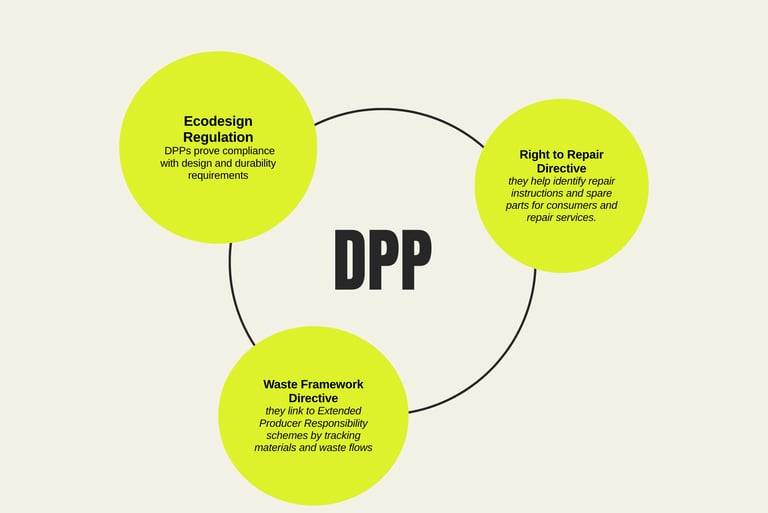Digital Product Passports for Fashion: EU Textile Rules Explained
Understand how Digital Product Passports will change clothing production, data, and repairability under new EU textile rules.
10/14/20255 min read


Digital Product Passports Are Coming to Fashion - What You Need to Know Now
A few years ago, talking about “data for garments” felt futuristic. Today, it’s official EU policy. Every clothing and textile product sold in the European Union will soon carry a Digital Product Passport (DPP) - a structured digital record showing what it’s made of, how it was produced, and how it can be repaired or recycled.
This is not just another label. It’s the backbone of how Europe plans to make products circular. And for fashion SMEs, it’s a big shift in how collections are designed, documented, and communicated.
Why Digital Product Passports Exist
Textiles are one of the largest sources of waste and lost materials in Europe. Only a small share is reused or recycled, while most ends up in landfills or incinerators. Policymakers understood that without reliable data on materials and supply chains, circularity would remain a theory.
The Digital Product Passport idea emerged from the European Green Deal and was formally written into law through the Ecodesign for Sustainable Products Regulation - known as ESPR .
The logic is straightforward: if everyone in the value chain, from fibre producer to consumer, has access to verified product information, waste can turn into resources. Transparency becomes the key to better design, better repair, and smarter recycling.
What the DPP Will Contain
The Digital Product Passport will hold data fields covering a garment’s materials, production, and repairability. Some fields are already confirmed by the European Commission, others are still under technical discussion.
What’s already known:
Unique product identifier - each item or batch will have a digital ID (likely QR or RFID).
Material composition - including percentage of recycled and renewable content.
Information on substances of concern - transparency about chemicals that affect recyclability.
Repairability and durability details - expected lifespan, repair instructions, spare part availability.
Recyclability and end-of-life information - how the item can be sorted and processed for reuse or recycling.
Responsible actors - brand name, manufacturer, importer, and compliance contact.
What’s still being decided:
Social and environmental performance data - whether worker conditions or carbon data will be mandatory.
Access rights - who can see what information: recyclers, consumers, or only regulators.
Data storage model - centralised EU database vs. decentralised blockchain-like systems.
Data standardisation - the exact file formats and communication protocols between systems.
The CIRPASS and CIRPASS-2 EU-funded pilot projects are testing technical options for data exchange, authentication, and SME integration. Their results will inform the final delegated acts that define textile DPP rules.
When It Will Apply
Under the ESPR, the textile and footwear sectors are among the first product groups selected for DPP rollout. The Commission plans to publish detailed textile requirements between 2025 and 2026, with enforcement expected around 2027.
That means brands selling into the EU market have roughly two years to prepare, which in product development terms, is very little time.
Why This Matters for You
At first glance, it sounds bureaucratic. Another layer of documentation. Another tech system to maintain. But if approached strategically, the DPP can make small and mid-sized brands more competitive.
1. Proof of transparency
Customers, retailers, and investors are asking for proof of sustainability. The DPP provides verifiable product data, not marketing claims. It’s an opportunity to back every statement with evidence.
2. Supply chain clarity
Brands will have to know where materials come from, what treatments they undergo, and who handles production. That’s valuable business intelligence, not just compliance paperwork.
3. Design feedback loop
Durability and repairability data will create measurable performance benchmarks. Brands can finally see how design choices affect product longevity and recyclability.
4. Access to future resale and recycling networks
Many circular systems, from textile recycling hubs to resale platforms, will require DPP data for sorting and verification. Having this in place early opens new revenue channels.
What Preparation Looks Like
No brand is expected to have a digital passport ready tomorrow. But early preparation makes adoption much smoother. Start with what’s already in your control.
Map your product data.
Create a basic digital record for each style: materials, supplier names, production steps, care and repair notes. Even an Excel sheet works as a starting point. This mirrors how official data fields will be structured later.
Check your material transparency.
Can you trace your fabrics down to fiber level? Do your suppliers disclose chemical treatments or recycled content? Those gaps will matter once DPP rules become mandatory.
Audit your repair and durability information.
The regulation calls for brands to disclose repairability metrics, things like available spare parts or expected lifetime. If you don’t measure these yet, start now.
Explore digital ID technology.
QR codes, NFC chips, or blockchain identifiers, there’s no single solution yet. But testing one on a pilot product can help your team understand future workflows.
Follow national and EU pilots.
The Technical Backbone
The European Commission envisions a decentralised architecture, data won’t all live in one EU database. Each company will host or link its own product data but in a standardised format that can be read by authorised users.
Interoperability, the ability of systems to “talk” to each other, is critical. A fabric supplier’s data should flow automatically into a brand’s system, which then connects with recyclers or retailers. That’s why the Commission is working with standardisation bodies like CEN and ISO to define digital identifiers and common data models.
For SMEs, the main takeaway is this: your product information will need to be structured, accurate, and shareable. The tools will likely integrate into PLM or ERP systems, but the data quality must start with you.
How DPPs Connect With Other EU Rules
The DPP isn’t a standalone initiative. It’s part of a wider ecosystem of circular economy laws that all interact.
Under the Ecodesign Regulation, DPPs prove compliance with design and durability requirements.
Under the Waste Framework Directive (EU) 2025/1892, they link to Extended Producer Responsibility schemes by tracking materials and waste flows.
Under the Right to Repair Directive (2024), they help identify repair instructions and spare parts for consumers and repair services.
Together, these create a single digital thread across the product lifecycle, from manufacturing to end-of-life.
Why Acting Early Makes Sense
By the time the textile DPP becomes law, data collection, supplier mapping, and system integration will already take months of work. Early movers will have an advantage in building trust with regulators and clients.
We’re already helping brands prepare by:
Structuring supplier data in DPP-compatible formats.
Designing repairability reporting templates.
Running product data audits for future passport integration.
These steps don’t just meet policy demands, they make operations leaner, reduce risk, and strengthen collaboration across supply chains.
Looking Ahead
The Digital Product Passport will redefine what transparency means in fashion. It’s not marketing copy anymore, it’s verifiable data. That’s a shift worth embracing.
By 2027, every clothing item sold in the EU will likely carry a digital identity. Those who prepare early will not only comply but lead, showing customers, partners, and policymakers that accountability and innovation can go hand in hand.
We’re here to help you make that shift. Step by step, without overcomplication.


